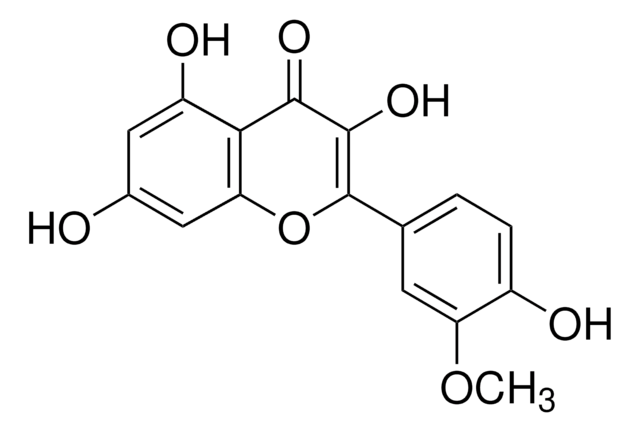This material has been purified from a plant source. This information may be found on the lot specific Certificate of Origin. Please navigate to the ‘DOCUMENTATION’ section of the Product Detail Page to access a certificate under the ‘Certificate of Origin’ tab:
https://www.sigmaaldrich.com/product/sigma/q4951#product-documentation
Q4951
Quercetin
≥95% (HPLC), solid, flavonoid antioxidant
Sinónimos:
2-(3,4-Dihydroxyphenyl)-3,5,7-trihydroxy-4H-1-benzopyran-4-one, 3,3′,4′,5,6-Pentahydroxyflavone
About This Item
Productos recomendados
Nombre del producto
Quercetin, ≥95% (HPLC), solid
origen biológico
synthetic (organic)
Ensayo
≥95% (HPLC)
Formulario
solid
mp
316.5 °C
solubilidad
water: practically insoluble
temp. de almacenamiento
room temp
cadena SMILES
OC1=CC(O)=C2C(OC(C3=CC=C(O)C(O)=C3)=C(O)C2=O)=C1
InChI
1S/C15H10O7/c16-7-4-10(19)12-11(5-7)22-15(14(21)13(12)20)6-1-2-8(17)9(18)3-6/h1-5,16-19,21H
Clave InChI
REFJWTPEDVJJIY-UHFFFAOYSA-N
¿Está buscando productos similares? Visita Guía de comparación de productos
Descripción general
Aplicación
- Quercetin has been used as an antioxidant which reversed the immunosuppressive effects of high glucose and hyperglycemic sera in type 2 diabetic patients.[3]
- It has been used as a detoxifying phytochemical in Apis mellifera.[4]
- It has been used as a positive control in DPPH (2,2- diphenyl-1-picryhydrazyl) radical scavenging assay. It has also been used for the preparation of calibration curve to determine total flavonoid content.[5]
Acciones bioquímicas o fisiológicas
Características y beneficios
Nota de preparación
Palabra de señalización
Danger
Frases de peligro
Consejos de prudencia
Clasificaciones de peligro
Acute Tox. 3 Oral
Código de clase de almacenamiento
6.1C - Combustible acute toxic Cat.3 / toxic compounds or compounds which causing chronic effects
Clase de riesgo para el agua (WGK)
WGK 3
Equipo de protección personal
Eyeshields, Faceshields, Gloves, type P2 (EN 143) respirator cartridges
Elija entre una de las versiones más recientes:
Certificados de análisis (COA)
¿No ve la versión correcta?
Si necesita una versión concreta, puede buscar un certificado específico por el número de lote.
¿Ya tiene este producto?
Encuentre la documentación para los productos que ha comprado recientemente en la Biblioteca de documentos.
Los clientes también vieron
Artículos
Fatty acid synthesis supports cancer cell proliferation, essential for membrane generation, protein modification, and bioenergetics.
Fatty acid synthesis supports cancer cell proliferation, essential for membrane generation, protein modification, and bioenergetics.
Fatty acid synthesis supports cancer cell proliferation, essential for membrane generation, protein modification, and bioenergetics.
Fatty acid synthesis supports cancer cell proliferation, essential for membrane generation, protein modification, and bioenergetics.
Protocolos
Protocol for HPLC Analysis of Flavonoids on Ascentis® RP-Amide
-
What is the Source of Extraction of Quercetin Q4951?
1 answer-
Helpful?
-
-
How can I store a solution of Quercetin Q4951 30 mg/ml in DMSO?
1 answer-
The long term solution stability of this material has not been determined.
Helpful?
-
-
Can you provide me the HPLC Peak Sheets ?
1 answer-
The documentation you are requesting can be supplied by our Technical Service team who can assist you with further. We kindly ask you to navigate to the link https://www.sigmaaldrich.com/techservice, click on "Product Documentation" under the Products Section with all the required information so that a member of our team can reach out to you to assist further. Thank you.
Helpful?
-
-
What is the range of absorbance wavelength for this product?
1 answer-
The absorbance spectrum of this product is not determined. See the link below to a publication that may be helpful.
https://www.sciencedirect.com/science/article/pii/S0308814616307142#:~:text=In%20the%20UV%E2%80%93visible%20range,constants%20are%20ionic%20strength%20dependent.Helpful?
-
-
what is the solubility of this product in DMSO?
1 answer-
This chemical is soluble in DMSO (30 mg/ml), DMF (~30 mg/ml), and ethanol (~2 mg/ml).
Helpful?
-
Active Filters
Nuestro equipo de científicos tiene experiencia en todas las áreas de investigación: Ciencias de la vida, Ciencia de los materiales, Síntesis química, Cromatografía, Analítica y muchas otras.
Póngase en contacto con el Servicio técnico















